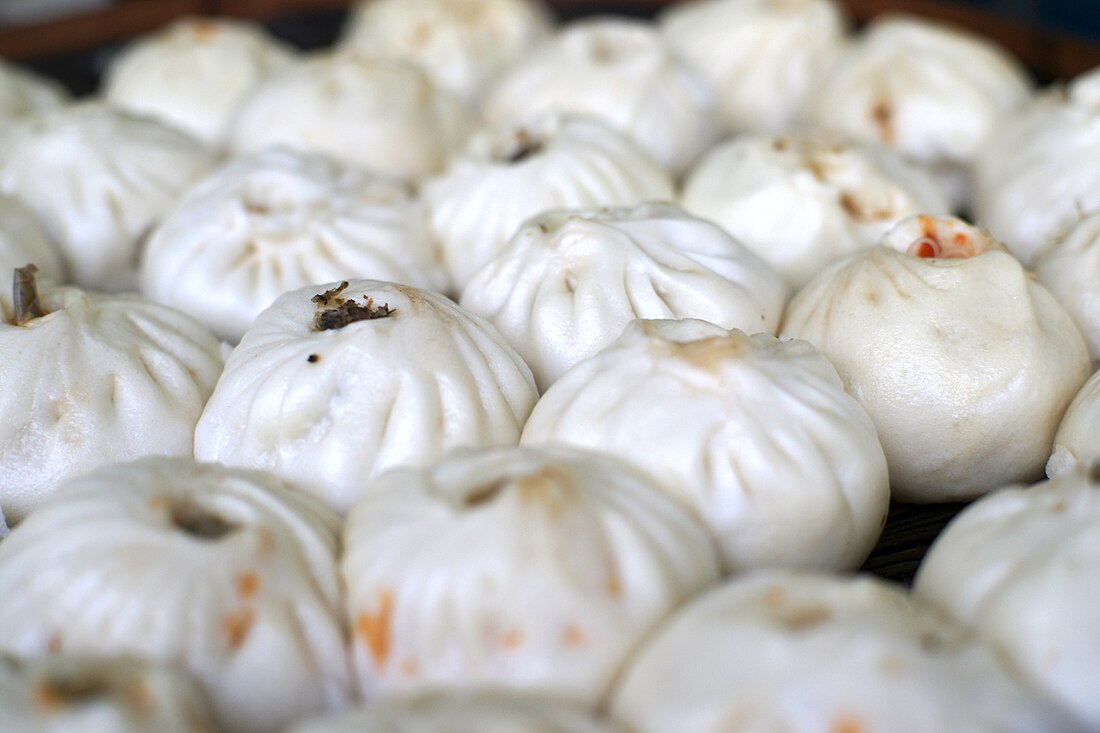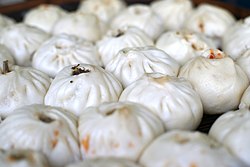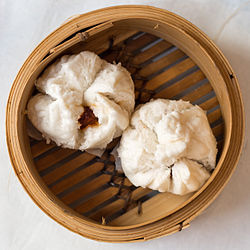Top Qs
Timeline
Chat
Perspective
Baozi
Chinese filled bun From Wikipedia, the free encyclopedia
Remove ads
Baozi (Chinese: ⓘ), or simply bao, is a type of yeast-leavened filled bun[1] in various Chinese cuisines. There are many variations in fillings (meat or vegetarian) and preparations, though the buns are most often made from wheat flour and steamed. They are a variation of mantou from Northern China.
This article needs additional citations for verification. (September 2014) |
Baozi are popular throughout China and have even made their way into the cuisines of many other countries through the Chinese diaspora.
Remove ads
History and etymology
Written records from the Song dynasty show the term baozi in use for filled buns.[2][3] Prior to the Northern Song dynasty (960–1279), the word mantou was used for both filled and unfilled buns.[4] According to legend, the filled baozi is a variation of manta invented by military strategist Zhuge Liang.[5] Over time mantou came to indicate only unfilled buns in Mandarin and some varieties of Chinese, although the Wu Chinese languages continue to use mantou to refer to both filled and unfilled buns.[citation needed]
Remove ads
Types
Summarize
Perspective
Remove ads
Regional
Gua bao (Min Nan: 割包, romanized: koah-pau, Min Nan: 虎咬豬, romanized: hó͘-kā-ti) originated as Fujianese street food. Unlike other types of bao, gua bao is made by folding over the flat steamed dough and is thus open. It is designed to fit easily in one's hands and has a wide variety of fillings.
Outside of China
Summarize
Perspective

In many Chinese cultures, these buns are a popular food, and widely available.[1] While they can be eaten at any meal, baozi are often eaten for breakfast. They are also popular as a portable snack or meal.
The dish has also become commonplace throughout various regions of Northeast Asia with cultural and ethnic relationships, as well as Southeast Asia and outside Asia due to longstanding Chinese immigration.
- In Buryatia and Mongolia, variants of the recipe, often with beef or lamb, are known as buuz and buuza.[6][7]
- Given the long history of the Chinese diaspora in Malaysia before the British colonial times, the Malays have adopted these buns (called pau in Malay) as their own with halal fillings particularly with curry (potato, chicken, or beef) similar to curry puffs; some variants have a quail egg in the middle, in addition. Other variations include sweet fillings of coconut jam (kaya) or red bean paste. These pau can be found sold in stalls by the roadside, at night markets, highway rest stops, and pasar Ramadan (Ramadan food bazaars).
- Similarly, in Indonesia the dish has been adopted into Indonesian cuisine through the integration of Chinese culture. It has been adopted through the Hokkien language name of bakpau or bakpao. In addition to meat fillings, local variants include: chocolate, sweet potato, and marmalade fillings. Bakpau is found in Indonesia as a take away food sold by cart street hawkers. Bakpau in Indonesia is usually sold in dabao size (lit.: "big pau"), around 10 cm in diameter. To accommodate the dietary restrictions of Indonesia's Muslim majority, the original pork filling has been replaced with minced beef, diced chicken, or even sweet mung bean paste and red bean paste. Pau with non-meat fillings are still called bakpau by Indonesians, despite the lack of meat. It is usually served with sweet chili sauce.
- Due to influence from Indonesia, supermarkets in the Netherlands commonly have in stock what the Dutch call bapao or sometimes bakpao. One can easily find frozen or sometimes in the bigger supermarkets cooled bapao/bakpao wrapped in plastic, ready-made to be heated inside a microwave. The most prevalent filling is chicken, although there are also pork, beef, and vegetarian variants widely available. This food is categorized as a quick snack or a fast-food item. Freshly baked forms of this steamed bun are not a staple food item in the Netherlands outside of the Chinese community living there.
- In the Philippines, the local version of baozi is called siopao brought by Chinese immigrants (Sangleys) prior to Spanish colonialism.[8][9] Varieties of Filipino siopao fillings include barbecued pork, meatballs, flaked tuna, and sometimes chocolate and cheese.
- A similar concept is also present in Thailand, called salapao (ซาลาเปา).
- Baozi is also very popular in Japan where it is known as chūkaman (中華まん, '"Chinese steamed bun"'). Nikuman (肉まん; derived from 肉饅頭, nikumanjū) is the Japanese name for Chinese baozi with meat fillings. Chūkaman are steamed and often sold as street food. During festivals, they are frequently sold and eaten. From about August or September, through the winter months until roughly the beginning of April, chūkaman are available at convenience stores, where they are kept hot.
- In Korea, there are two varieties of dumplings similar to baozi. One variety, a longtime staple at Korean-style Chinese restaurants, is known simply as jjinmandu, or "steamed mandu", which is typically savory and comes with meat, vegetable, and noodle fillings. Another variation is a warm snack food consisting of a completely round bun usually filled with smooth, sweetened red bean paste but also commonly sold stuffed with vegetables and meat, pizza toppings, pumpkin, or buldak. This is known as jjinppang (steamed bread or bun) or hoppang (a convenience-food version of the former).

- The Cambodian version, num pao (នំប៉ាវ), is a popular street food.[10]
- Bánh bao is the Vietnamese version of the Cantonese tai bao that was brought over by Chinese immigrants.
- The Myanmar version is called pauk-si (ပေါက်စီ)[11][12] and is a popular snack available in almost every traditional tea shop.
- In Mauritius, many dishes are influenced by Sino-Mauritians;[13] this includes baozi, simply referred to as "pao" (sometimes written as "pow" or "paw").[14][15][16] They are typically filled with Chinese sausage, poultry, black mushroom, and soy egg, among others.[14][17]
Remove ads
See also
References
Wikiwand - on
Seamless Wikipedia browsing. On steroids.
Remove ads








